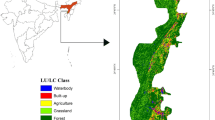Abstract
Deforestation, fragmentation and fires are habitat transformers and responsible for loss of biodiversity. This study attempts to evaluate threat status of forest ecosystems by determining regional-level hot spots of deforestation, fragmentation and fires in Myanmar. The states of Ayeyarwady, Mandalay and Nay Pyi Taw have the highest annual rate of deforestation from 2005 to 2016. There is a significant reduction in spatial extent of large core forest. Mandalay and Nay Pyi Taw had shown more than 20% of loss in large core forest from 2005 to 2016. Geospatial analysis indicates all the major forest types were affected by fires during 2003 to 2017. The study found that dry deciduous forests were highly affected by fires. More than 60% of the forest area of Magway, Mandalay, Chin, Kayah, Kayin and Shan had found to be under forest fire hot spot. Comparative spatial assessment was carried out on fire hot spots, deforested and fragmented landscapes to provide overview of priority conservation areas. The study identified five states in Myanmar affected by multiple threats and categorised as Conservation Priority Hot Spot I, eight states as Conservation Priority Hot Spot II and two states as low-risk areas categorised as Conservation Priority Hot Spot III. The analysis of hot spots of deforestation, fragmentation and fires provides a consistent way of ecosystem monitoring and biodiversity conservation in Myanmar. The study demonstrates repeatable earth observations as an important prerequisite for sustainable forest management in Myanmar.







Similar content being viewed by others
References
Baker, P. J., & Bunyavejchewin, S. (2009). Fire behaviour and fire effects across the forest landscape of continental Southeast Asia. In Tropical fire ecology (pp. 311–334). Springer, Berlin.
Biswas, S., Vadrevu, K. P., Lwin, Z. M., & Lasko, K. (2015). Factors controlling vegetation fires in protected and non-protected areas of Myanmar. PLoS ONE, 10(4), e0124346.
Dudgeon, D. (2002). The most endangered ecosystems in the world? Conservation of riverine biodiversity in Asia. Internationale Vereinigung für theoretische und angewandte Limnologie: Verhandlungen, 28(1), 59–68.
FAO. (2006). Global forest resource assessment 2005 progress towards sustainable forest management. Rome: UN Food and Agriculture Organization.
FAO. (2011). Assessing forest degradation-towards the development of globally applicable guidelines. Forest Resources Assessment Working Paper. 177.
FAO. (2015). Global forest resource assessment. Rome: UN Food and Agriculture Organization.
Gadgil, M. (1990). India’s deforestation: Patterns and processes. Society and Natural Resources, 3, 131–143.
Getis, A., & Ord, J. K. (1992). The analysis of spatial association by use of distance statistics. Geographical Anlaysis, 24(3), 189–206.
Htun, N. Z., Mizoue, N., Kajisa, T., & Yoshida, S. (2009). Deforestation and forest degradation as measures of Popa Mountain Park (Myanmar) effectiveness. Environmental Conservation, 36(3), 218–224.
IPCC. (2014). Climate change 2014: Impacts, adaptation, and vulnerability. Part A: Global and sectoral aspects. Contribution of working group II to the fifth assessment report of the intergovernmental panel on climate change, Cambridge University Press, Cambridge.
Lim, C. L., Prescott, G. W., De Alban, J. D. T., Ziegler, A. D., & Webb, E. L. (2017). Untangling the proximate causes and underlying drivers of deforestation and forest degradation in Myanmar. Conservation Biology, 31(6), 1362–1372.
Liu, F. J., Huang, C., Pang, Y., Li, M., Song, D. X., Song, X. P., et al. (2016). Assessment of the three factors affecting Myanmar’s forest cover change using Landsat and MODIS vegetation continuous fields data. International Journal of Digital Earth, 9(6), 562–585.
Moloney, K. A., & Levin, S. A. (1996). The effects of disturbance architecture on landscape-level population dynamics. Ecology, 77(2), 375–394.
Myers, N., Mittermeier, R. A., Mittermeier, C. G., Da Fonseca, G. A., & Kent, J. (2000). Biodiversity hotspots for conservation priorities. Nature, 403(6772), 853–858.
Puyravaud, J. P. (2003). Standardizing the calculation of the annual rate of deforestation. Forest Ecol Manag, 177, 593–596.
Reddy, C. S., Khuroo, A. A., Harikrishna, P., Saranya, K. R. L., Jha, C. S., & Dadhwal, V. K. (2014). Threat evaluation for biodiversity conservation of forest ecosystems using geospatial techniques: A case study of Odisha, India. Ecological Engineering, 69, 287–303.
Reddy, C. S., Pasha, S. V., Satish, K. V., Unnikrishnan, A., Chavan, S. B., Jha, C. S., et al. (2019). Quantifying and predicting multi-decadal forest cover changes in Myanmar: A biodiversity hotspot under threat. Biodiversity and Conservation. https://doi.org/10.1007/s10531-019-01714-x.
Rodriguez, N., Armenteras, D., Molowny-Horas, R., & Retana, J. (2012). Patterns and trends of forest loss in the Colombian Guyana. Biotropica, 44(1), 123–132.
Rodríguez, J. P., Clark, K. M., Baillie, J. E., et al. (2011). Establishing IUCN red list criteriafor threatened ecosystems. Conservation Biology, 25, 21–29.
UNCCD. (2005). The union of Myanmar ministry of forest. Myanmar: Yangon.
Unnikrishnan, A. (2018). Threat evaluation of forest ecosystems in Myanmar using geospatial techniques. M.Phil. Dissertation. Cochin University, Kerala.
Vadrevu, K. P. R. (2011). Vegetation fire in the Asian Region: Satellite observational needs and priorities. Global Environmental Research, 15(1), 65–76.
Vogt, P., Riitters, K., Estreguil, C., Kozak, J., Wade, T., & Wickham, J. (2007). Mapping spatial patterns with morphological image processing. Landscape Ecology, 22, 171e177.
White, P. S., & Pickett, S. T. A. (1985). Natural disturbance and patch dynamics: An introduction. In S. T. A. Pickett & P. S. White (Eds.), The ecology of natural disturbance and patch dynamics (pp. 3–13). Cambridge: Academic Press.
Wikramanayake, E., Dinerstein, E., Loucks, C., & Olson, D. (2001). Terrestrial ecoregions of the Indo-Pacific: A conservation assessment (p. 643). Washington, DC: Island Press.
Acknowledgements
This work has been carried out as part of ISRO’s National Carbon Project. We gratefully acknowledge ISRO-DOS Geosphere Biosphere Programme for supporting this research. We are thankful to Director, NRSC, Deputy Director, RSA, NRSC, and Group Director, FEG, NRSC, for suggestions and encouragement.
Author information
Authors and Affiliations
Corresponding author
Additional information
Publisher's Note
Springer Nature remains neutral with regard to jurisdictional claims in published maps and institutional affiliations.
About this article
Cite this article
Reddy, C.S., Unnikrishnan, A., Asra, M. et al. Spatial Conservation Prioritisation of Threatened Forest Ecosystems in Myanmar. J Indian Soc Remote Sens 47, 1737–1749 (2019). https://doi.org/10.1007/s12524-019-01025-2
Received:
Accepted:
Published:
Issue Date:
DOI: https://doi.org/10.1007/s12524-019-01025-2




